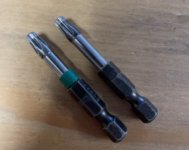Customer fucked up and torqued a Sig red dot to his rail with 20 ft lbs, instead on inch pounds...
The T-10 tips aren't strong enough to break this free- they snap off clean leaving the screw head intact and undamaged.
I put some Kroil on it to see if it might soak in enough to lessen the force needed to break this free but no go.
I'm thinking some judicious heat around the end of the screw (it's a thru-bolt type mount) where it pokes out of the plate it's screwed into?
Any other suggestions? Trying to avoid treating it like a snapped-off scope mount screw and drilling it out on the mill.
The T-10 tips aren't strong enough to break this free- they snap off clean leaving the screw head intact and undamaged.
I put some Kroil on it to see if it might soak in enough to lessen the force needed to break this free but no go.
I'm thinking some judicious heat around the end of the screw (it's a thru-bolt type mount) where it pokes out of the plate it's screwed into?
Any other suggestions? Trying to avoid treating it like a snapped-off scope mount screw and drilling it out on the mill.

